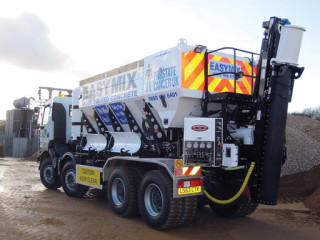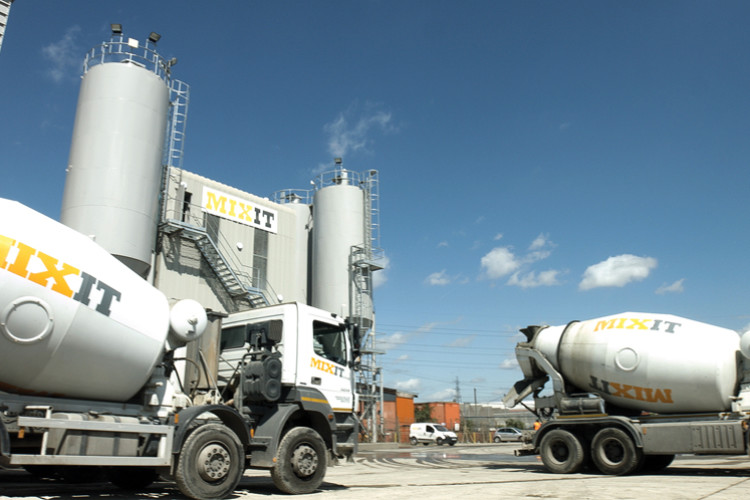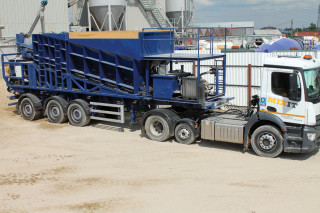We’re all used to seeing truck-mounted cement mixers bowling along, their voluminous drums rotating slowly to keep the mix from going off.
But they’re not the only type of concrete mixer on today’s roads. Gradually, over a period of several years, volumetric concrete mixers have become more common – and not everybody’s happy about it.
Volumetric mixers – also known as mobile batching plants or batched-on-site-mixers – are bigger and altogether more complicated pieces of equipment.
Instead of collecting ready-mixed concrete from the supplier’s central batching plant and delivering it just-in-time to the customer, these machines carry all the component materials (cement, aggregate, water and any admixtures) in separate compartments on board and mix it for the customer right there on site.
You can see the advantages: A volumetric mixer can supply several customers in one trip, delivering a different mix each time if necessary. It’s ideal for small jobs and it can operate ‘out-of-hours’, when a fixed batching plant would be unavailable.
But for the past couple of years, the Department for Transport has been planning to tighten up the regulatory mechanism that has so far exempted volumetric mixers from many of the restrictions imposed upon normal HGVs.
Volumetric mixers – like some other items of plant including mobile cranes and concrete pumps – pay a lot less road tax: around £165 instead of the £650 or £1,200 paid by commercial vehicles.
Their drivers don’t need to use tachographs nor adhere to European drivers’ hours rules and the owners don’t need an Operator’s (O) licence and all the red tape that involves.
Crucially, HGV weight restrictions don’t apply to engineering plant either. A four-axle HGV is limited to 32 tonnes gvw but a four-axle volumetric mixer will often travel in excess of 40 or even 50 tonnes.
Ever since 2011, when the DfT first indicated that it was looking to shake up the requirements, a row has been brewing in the concrete world about the status of these machines.
Things came to a head last year when two leading trade associations clashed over the matter. In March 2015 the Minerals Products Association, which represents many of the leading ready-mix companies, called on the government to close what it saw as the regulatory loopholes.
“MPA is not against volumetrics which supply 10% of ready-mixed concrete and make an important contribution to the market,” said MPA chief executive Nigel Jackson.
“However,” he continued, “it is unacceptable that for years they have been able to take advantage of loopholes in the law and operate as engineering plant, thereby being able to ignore the maximum weight, drivers’ hours and operator licensing requirements which apply to HGVs”.
But the British Aggregates Association, whose members comprise independent quarry operators, lent its support to the Batched on Site Association (BSA), which represents the majority of companies that operate volumetric mixers. The BAA even went so far as to dub the machines “cartel-busters” because they allow small independents to compete with the multinationals.
The DfT issued two consultations, one to gauge opinion on the MoT requirements and another on the need for O-licensing. And although the results of these two exercises were expected to be announced before Christmas, nothing has been forthcoming.
“We had a meeting with the Department in mid-January and it looks as though MoTs are coming in, O-licensing is coming in there’s talk of a non-standard weight provision,” comments Jared Dunbar, a specialist with Chester law-firm Dyne Solicitors and co-ordinator for the BSA.
Dunbar says BSA members don’t have a problem with MoTs or even operator licensing. “We understand the benefits of licensing on safety grounds – there might even be advantages as it would help clean up the less professional end of the market,” he says.
As for MoTs: “Nearly all our members already carry out the necessary maintenance and regular checks that are required, so that’s not a problem,” he says.
The problem is weight. “A 32 tonne drum mixer can carry 8m3–9m3 of concrete. But a volumetric mixer has to carry all its own batching machinery so it’s much heavier. If we were limited to 32 tonnes we’d only be able to carry about 4m3”. That would make volumetric mixers economically unviable, says Dunbar.
“The DfT says it understands the economic implications but at our meeting in January we asked why concrete pumps were to be exempted from O-licences and MoT requirements and the officials at the meeting seemed unaware of that fact.” A change in personnel at the Department last year has robbed the negotiations of any continuity, says Dunbar.
There is however talk in the Department of a compromise solution in the form of a “non-standard weight provision”. What that crucial weight limit might be is anyone’s guess, says Dunbar, but he thinks most BSA members “could live with 40 tonnes”.

So by the summer of this year, there might a solution on the table. In the meantime, the industry continues to argue the pros and cons.
Just before Christmas, Jim Taylor, owner of east London concrete supplier Modern Mix (which also trades as Mixit) called for an outright ban on volumetric mixers, arguing that they are a danger on the roads and that the concrete they produce is of unreliable quality.
Taylor himself ran up to a dozen volumetric mixers until only a few months ago and his vehicles, bearing the slogan “Jim’ll Mix It” (now abandoned for obvious reasons, he assures us), were a common site in the London area. But he claims that they proved to be nothing but trouble.

First, the question of quality: “Quality concrete is weigh-batched,” he insists, “and as the name suggests, volumetric mixers batch by volume.” Cement powder, in particular, is difficult to measure accurately by volume as it can settle during transit, becoming denser and occupying a smaller volume.
“I had problems with my mixes,” says Taylor. “For example, I mixed some screed for a client and had to pump it up to the third floor. The material didn’t go off for a week.”
Mixing your concrete out on site, rather than in the controlled environment of a conventional ready-mix yard, introduces too many risks, says Taylor.
“There’s no traceability. If you’re two barrow-loads short, how do you know whether someone miscalculated or whether your driver held those loads back? It’s been too easy to fix the paperwork with site batching, whereas off-site batching is a very precise and accurate procedure – it’s all computerised,” he says.
Whether it was the volumetric machines attracting rogues or just Taylor’s bad luck, it is nevertheless a fact (he assures us) that of his 12 drivers he had to dismiss eight for dishonesty.
Jared Dunbar at the BSA lauds the fact that volumetric mixers allow the small guy to compete with the multinationals. But Taylor’s not a multinational and he sees it differently:
“It’s a condition of my O-licence that I have to have a minimum ‘financial standing’ of £4,100 for each one of my vehicles to prove I have the necessary resources to run the fleet,” he says.
“My vehicles are serviced every eight weeks without fail and have their annual MoTs. How many of these people running volumetric mixers can say that? And they all run on red diesel – is that fair?”
The facts, as he sees it, are clear: volumetric mixers are heavy goods vehicles and should be treated the same as all other HGVs.
“They operate like normal delivery vehicles – how is that any different to what I’m doing? If they were visiting one or two sites a day, then fair enough, that’s normal for plant. But if they’re dropping off at several sites throughout the day, that’s quite different because they’re spending a lot more time on the road.
You might wonder why Jim Taylor has chosen this moment to stick his head above the parapet – after all, it looks as though the DfT is poised to act.
The answer possibly lies in the fact that Taylor is about to roll out a new piece of kit – a six-axle on-site batching trailer designed and built by himself with the assistance of Sheffield-based Neilson Hydraulics and Cantech Controls of Henley-on-Thames.
Dubbed the “Kaizen” (the Japanese word for the process of continuous improvement) this mixer produces on-site mixes which are batched not by volume but by weight, using a fully-computerised system. “It’s all totally traceable,” says Taylor.
Furthermore, he claims that the Kaizen mixer will use up to 20% less cement than a volumetric machine and consume roughly half the fuel. If volumetric mixers have to fall in line with other heavy goods vehicles, then the Kaizen mixer will be competing on a level playing field, says Taylor, who reckons he will have a competitive advantage.
Crucially, the 11m-long articulated vehicle can travel legally at 44 tonnes over six axles. And of course, it won’t be classified as “engineering plant” but as an HGV.
Got a story? Email news@theconstructionindex.co.uk




